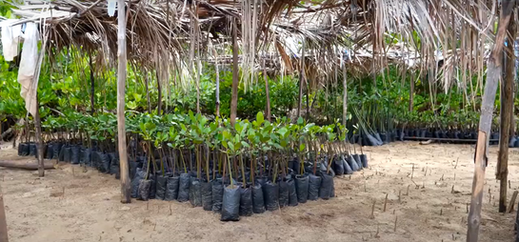The Vital Role of Mangroves in Lamu, Kenya
- eve
- Mar 21
- 3 min read
Updated: Mar 24

When the family breadwinner keeps coming home without the bread, you know you are all in trouble! This was the plight of women from Kipungani, a village at the Lamu Archipelago, Kenya. When their fishermen husbands kept coming home without fish, the women came together and formed Kipungani Women’s Group to help solve the root problem, by replanting and restoring mangroves.

Working under the Tusk Trust education program, PACE, and in partnership with Africa Underwater we made a film about the importance of mangroves and our work in mangrove management. In the film, we delved deep into scientific facts about mangroves, restorative measures in Lamu and threats still facing these unique trees that are rich carbon sinks.
Did you know that in Kenya, we have 9 species of mangroves, all of which are available in Lamu? Also, Lamu is the home of 70% of Kenya’s mangrove cover!
These trees are a reliable source of local livelihoods for the coastal community. The people of Lamu benefit greatly from mangroves in the following ways:
Revenue earned from tourists who go on sunset sails at the mangrove channels, where there is peace, calm and serenity. Moreover, we have over 50 species of birds residing in the Lamu Archipelago mangroves, so birdwatching tours are a favorite!
The calm waters are a great site for snorkeling, more so because of the rich biodiversity in these areas.

The fact the mangrove roots are an important marine habitat and a great fish breeding and nursery site means there are numerous fish and crabs present - a huge plus for the fishing community of Lamu.
There are traditional medicines begotten from mangroves.
~ The kaumwa, for one, is derived from a particular mangrove species and crushed on stone to form a paste that is applied on wounds with pus to dry them up.
~ Traditionalists also know how to extract powder from some mangrove seeds, that can be used to cure a chronic cough.
~ Some mangrove roots are boiled and one can drink the water to relive stomach pains.

The historic dhows and boats of Lamu are made from mangroves, hence a reliable source of revenue for the boat-makers and fishermen.

We have roofs and ceilings made from mangroves as well as boritis that are used as poles for fencing gardens and homes.

Clearly, mangroves are an integral part of the Lamu economy, so we cannot stand and watch unsustainability practices play out unmitigated. Climate change, coastal development, widespread construction activities using logs from the mangroves and mismanagement of solid waste including plastics are significant threats facing mangroves of Lamu and the world at large. We commend Lamu youth and women groups working tirelessly to change this reality.

Aggrieved like the women from Kipungani, we started a mangroves restoration and management program in 2014 to contribute to taking care of these green gems. Our main aim was to engage the community in ceasing logging by sensitizing them on mangrove cover benefits and help in management and monitoring of the mangroves.

Students from our Environmental Kindness Clubs are our key ambassadors in the mangrove restoration project, working hand-in-hand with the community to plant and care for these trees. You should hear some of our students accurately describing the mangrove planting process, in the mangrove restoration PACE video!
The Kipungani Women’s Group is doing particularly well; they have been nurturing a thriving mangrove nursery for over 5 years now! Their hard work of watering the seedlings twice a week with freshwater and every other day with sea water is yielding fruits. Every 6 months, they divide the earnings from the seedlings amongst themselves, and help out their fishermen husbands to boost their family income.
Loosely translated from the video;

Logging mangroves is unsustainable. It is better to take care of mangroves because they end up supporting other economic activities like beekeeping, crab fattening and mariculture, supporting carbon credits and construction of ecolodges. ~ Lutfa
Won’t we just heed her words? Here is what you can do to protect mangroves:
Watch our film to know more about mangroves.
Donate to our mangrove restoration program.
Join local organizations in planting and managing mangroves.
Say no to logging; discourage anyone from cutting down mangroves.
Stay Tuned For Our Future Plans

We have a PACE Mangrove school program in the pipeline, fully supported by TUSK Trust. The program comes with a handbook on mangrove management and all details on the progress of this project so far. This will be rolled out to our environmental kindness clubs for the next generation of conservationists to gain all knowledge there is about mangroves in Lamu.
Stay tuned on our social media pages for timely updates.
Written by Evelyn Kimori
Pictures by Elke Korschen


























Comments